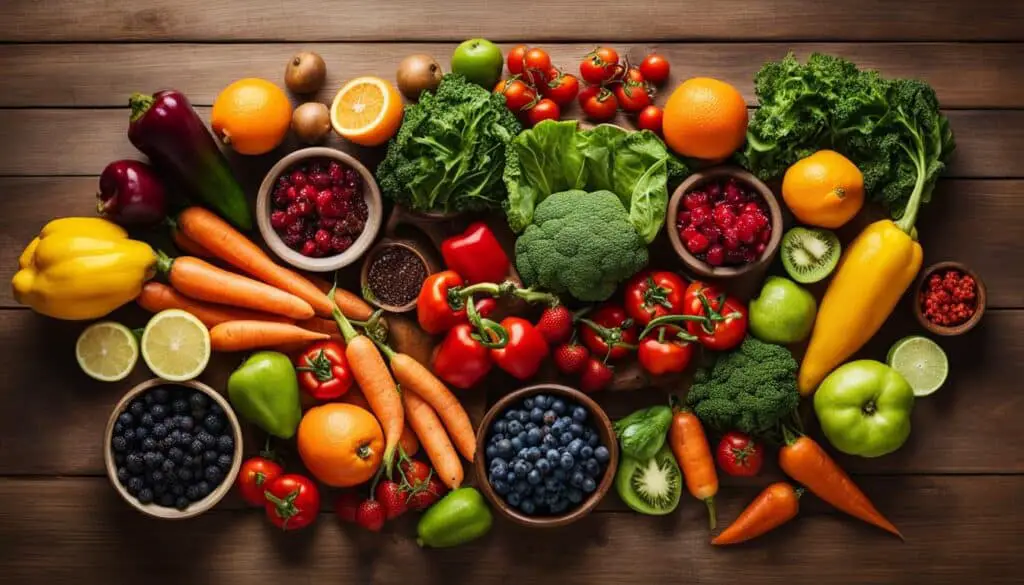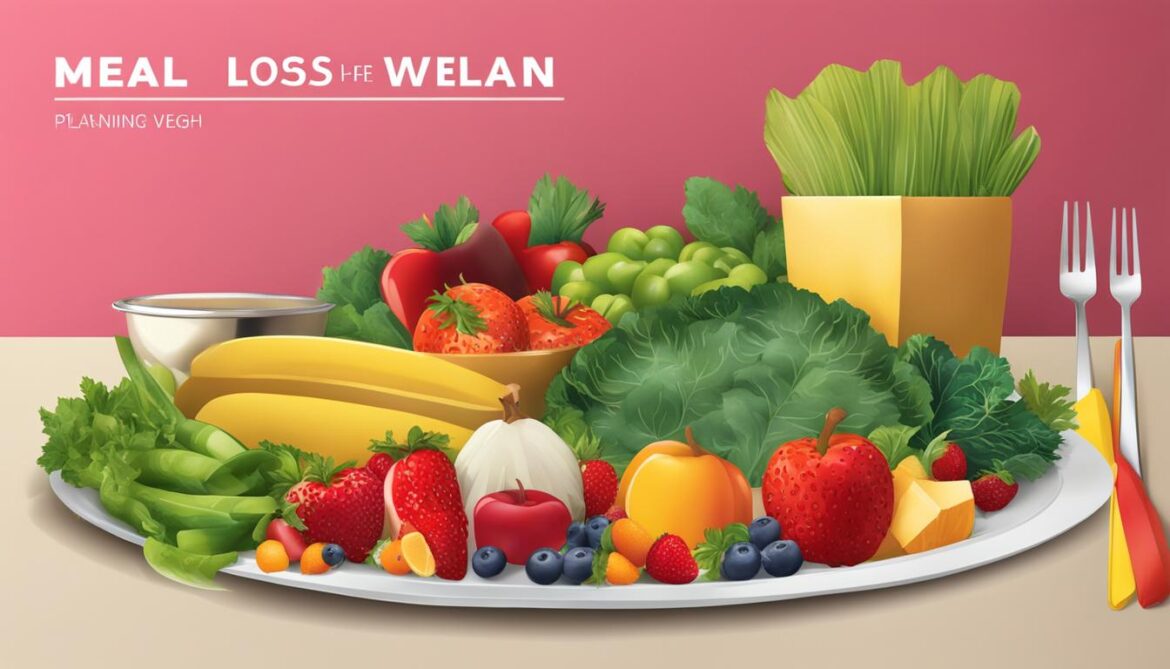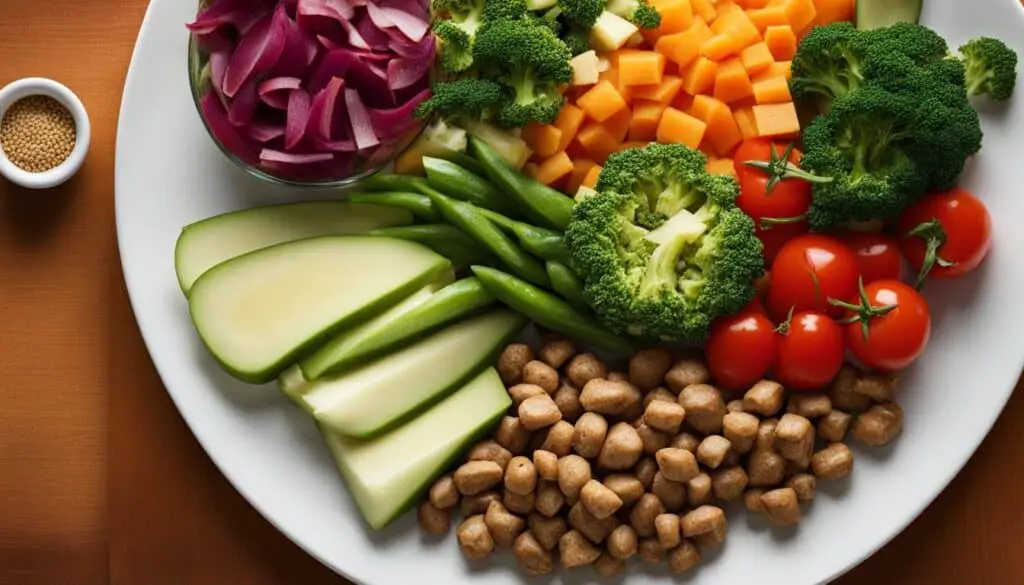When it comes to achieving lasting weight loss, one approach that has proven effective is creating a calorie-deficit meal plan. By consuming fewer calories than your body requires, you can create a calorie deficit, prompting your body to tap into stored fat for energy. It’s a sustainable way to shed those extra pounds and maintain a healthy weight in the long run.
To design a calorie-deficit meal plan, there are a few key factors to consider. First and foremost, it’s important to focus on nutrient-dense foods that provide your body with the necessary vitamins, minerals, and macronutrients. Secondly, portion sizes play a crucial role in ensuring you stay within your calorie limit. Lastly, meal timing can also impact the effectiveness of your weight loss journey.
Key Takeaways:
- A calorie-deficit meal plan involves consuming fewer calories than your body needs for weight maintenance.
- Creating a calorie deficit forces your body to use stored fat for energy, resulting in weight loss.
- Nutrient-dense foods, portion control, and strategic meal timing are essential considerations for designing an effective plan.
- Aim to include a variety of fruits, vegetables, lean proteins, whole grains, and healthy fats in your meals.
- Consulting with a healthcare professional or registered dietitian can help personalize your meal plan based on your individual needs and goals.
Understanding Calorie Deficit for Weight Loss
A calorie deficit is a key concept in achieving weight loss through proper energy balance. It occurs when you consume fewer calories than your body needs to maintain its current weight. This energy deficit prompts your body to utilize its stored fat as a source of energy, leading to gradual and sustainable weight loss.
To create a calorie deficit, there are two main approaches:
- Reduce calorie intake through diet: By carefully monitoring your food choices and portion sizes, you can reduce the number of calories you consume each day.
- Increase calorie expenditure through physical activity: Engaging in regular exercise and physical activity helps boost your calorie expenditure, contributing to your calorie deficit.
While both methods are effective, finding the right balance between calorie intake and expenditure is crucial for achieving effective weight loss. It’s important to maintain a calorie deficit that is sustainable and supportive of your overall health and well-being.
“To achieve weight loss, it’s essential to consume fewer calories than you burn. By creating a calorie deficit, you’re giving your body the opportunity to tap into stored fat and utilize it as fuel.”
To illustrate the relationship between calorie deficit and weight loss, consider the following hypothetical example:
| Calorie Intake (per day) | Calorie Expenditure (per day) | Calorie Deficit | Weight Loss |
|---|---|---|---|
| 2000 | 2500 | 500 | 0.5 lbs per week |
| 1500 | 2500 | 1000 | 1 lb per week |
| 1200 | 2500 | 1300 | 1.5 lbs per week |
This table demonstrates how a greater calorie deficit can lead to more significant weight loss over time. However, it’s important to note that extreme calorie deficits should be avoided, as they can negatively affect your overall health and metabolism.
By understanding and implementing a calorie deficit through proper diet and physical activity, you can achieve your weight loss goals while maintaining a balanced and sustainable approach to health and wellness.
Determining Your Calorie Needs
To create a successful calorie-deficit meal plan, it is essential to determine your calorie needs. This involves understanding your basal metabolic rate (BMR) and activity level, which are key factors in calculating your daily calorie requirements.
Your BMR represents the number of calories your body needs to function at rest, without any physical activity. It serves as the baseline for estimating your total daily calorie needs. Several equations can help you determine your BMR by considering factors such as age, gender, height, and weight.
Once you have calculated your BMR, you can then multiply it by an activity factor to estimate the number of calories you burn through physical activity. Activity factors typically range from sedentary (little to no exercise) to highly active (intense exercise or physically demanding job).
This estimated total calorie expenditure sets the foundation for creating a calorie-deficit meal plan. By consuming fewer calories than your total daily needs, you can create the calorie deficit necessary for weight loss. However, it is important to strike a balance and not drastically restrict your calorie intake, as this may negatively impact your energy levels and overall well-being.
Remember that everyone’s calorie needs are different, and it is always a good idea to consult with a healthcare professional or registered dietitian to determine the optimal calorie intake for your individual goals and circumstances. They can provide personalized recommendations based on your specific needs, taking into account factors such as overall health, activity level, and weight loss goals.
Building a Balanced Meal Plan
A calorie-deficit meal plan is not just about reducing calories; it should also prioritize providing your body with the necessary nutrients for optimal health. To achieve this, it is important to build a balanced meal plan that includes a variety of foods from different food groups. By incorporating a range of macronutrients and micronutrients, you can ensure that your body receives the essential fuel it needs to function properly.
Macronutrients
Macronutrients are the three main components of our diet that provide energy: carbohydrates, protein, and fat. Each macronutrient plays a vital role in our body’s functioning and should be included in a balanced meal plan.
Carbohydrates are the primary source of energy for our bodies. They can be found in foods such as fruits, vegetables, whole grains, and legumes. Opt for complex carbohydrates, as they provide sustained energy and are rich in fiber.
Protein is essential for building and repairing tissues, as well as supporting various body functions. Good sources of protein include lean meats, poultry, fish, dairy products, beans, and legumes. Incorporate a variety of protein sources into your meal plan for optimal nutrient intake.
Fats are important for hormone production, insulation, and the absorption of fat-soluble vitamins. Choose healthy fats such as avocados, nuts, seeds, and olive oil. Limit the intake of saturated and trans fats, found in processed and fried foods.
Micronutrients
Micronutrients are vitamins and minerals that our bodies need in smaller quantities but are essential for overall health and wellness. Including a wide variety of fruits, vegetables, whole grains, and lean proteins in your meal plan will help ensure you obtain these micronutrients.
Planning and Portion Control
When building a balanced meal plan, it is crucial to focus on whole, unprocessed foods that are both nutrient-dense and low in calories. These types of foods provide the necessary macronutrients and micronutrients while helping to maintain a calorie deficit.
Plan your meals in advance to ensure you have a well-balanced combination of carbohydrates, protein, and fats. Consider portion sizes to stay within your calorie limit while still providing your body with the nutrients it needs.
“A balanced meal plan is key to providing your body with the necessary macronutrients and micronutrients while maintaining a calorie deficit for weight loss.”
Choosing the Right Foods for Weight Loss
When designing your calorie-deficit meal plan, it is crucial to select foods that promote weight loss while providing essential nutrients. Opting for low-calorie foods that are rich in nutrients can help you achieve your weight loss goals effectively. Incorporating a variety of fruits, vegetables, whole grains, lean proteins, and healthy fats can greatly support your success.
These weight loss foods are not only low in calories but also high in fiber, which aids in feeling full and satisfied. Here are some key categories of foods to include in your meal plan:
- Fruits and vegetables: Filling half your plate with colorful fruits and vegetables not only adds variety to your diet but also ensures a nutrient-dense and low-calorie intake. They are excellent sources of vitamins, minerals, and fiber, helping you stay satisfied throughout the day.
- Whole grains: Incorporating whole grains, such as brown rice, quinoa, and whole-wheat bread, can provide a steady source of energy and fiber. These options are lower in calories and higher in nutrients compared to refined grains.
- Lean proteins: Including lean sources of protein, such as chicken breast, fish, tofu, or legumes, can enhance satiety and promote muscle growth. These foods are typically lower in calories and can provide a feeling of fullness.
- Healthy fats: Incorporating foods rich in healthy fats, such as avocados, nuts, and seeds, can help you feel satisfied and provide essential nutrients. These foods add flavor and richness to your meals while contributing to overall heart health.
By selecting weight loss foods that are low in calories but high in nutrients, you can fuel your body effectively while creating a calorie deficit. It is important to be mindful of portion sizes to align with your calorie goals.
Examples of Weight Loss Foods
| Food Group | Examples |
|---|---|
| Fruits | Apples, oranges, berries, grapes |
| Vegetables | Broccoli, spinach, peppers, carrots |
| Whole Grains | Quinoa, brown rice, oats, whole-wheat bread |
| Lean Proteins | Chicken breast, fish, tofu, lentils |
| Healthy Fats | Avocado, nuts, seeds, olive oil |
These are just a few examples of weight loss foods within each food group. Incorporating a variety of options will ensure you receive a wide array of nutrients while maintaining a calorie deficit for weight loss.

Meal Planning Tips for Weight Loss Success
Effective meal planning is key to successful weight loss. By carefully planning your meals and snacks in advance, you can avoid impulsive food choices that can sabotage your progress. Meal planning allows you to take control of your nutrition and ensure you’re consuming the right amount of calories to create a calorie deficit.
One important aspect of meal planning is portion control. Using portion control strategies helps you manage your calorie intake and prevents overeating. By measuring and controlling your portions, you can stay within your calorie limit without feeling deprived or unsatisfied.
Consider splitting your meals into smaller, more frequent meals throughout the day. This approach, known as meal frequency, can help control hunger and maintain steady energy levels. By eating smaller meals more frequently, you can avoid extreme hunger and cravings, making it easier to stick to your calorie-deficit meal plan.
Experiment with different meal timing strategies, such as intermittent fasting. Intermittent fasting involves restricting your eating window to a specific timeframe, such as 16 hours of fasting followed by an 8-hour eating window. This approach can be effective for some individuals in reducing calorie intake and promoting weight loss. Find what works best for you and tailor your meal timing to suit your lifestyle and preferences.
Benefits of Meal Planning for Weight Loss
Meal planning allows you to take control of your nutrition, ensuring you’re consuming the right amount of calories and sticking to your weight loss goals.
By planning your meals and snacks in advance, you can:
- Stay on track with your calorie deficit
- Avoid unhealthy food choices
- Save time and money by reducing food waste
- Ensure balanced nutrition with a variety of foods
With proper meal planning, you can increase your chances of achieving weight loss success and enjoying long-term results. Remember to consult with a healthcare professional or registered dietitian to personalize your meal plan based on your individual needs and goals.
Tips for Effective Meal Planning
To optimize your meal planning and make it a sustainable habit, consider the following tips:
- Set aside dedicated time each week to plan your meals and create a shopping list.
- Choose recipes that align with your weight loss goals and include a balance of macronutrients and micronutrients.
- Prep and portion your meals in advance to make healthy choices easily accessible.
- Include a variety of colorful fruits and vegetables to ensure you’re getting a range of vitamins and minerals.
- Experiment with new recipes and flavors to keep your meals interesting and prevent boredom.
Remember, successful weight loss is not just about calorie restriction but also about nourishing your body with nutritious foods. Meal planning can help you achieve this balance while promoting adherence to your weight loss journey.
Incorporating Exercise for Enhanced Weight Loss
Exercise is a crucial component of any weight loss journey, offering numerous benefits for both physical and mental health. By incorporating regular physical activity into your routine, you can enhance weight loss efforts and improve overall well-being.
When it comes to exercise, a combination of cardiovascular exercise and strength training yields optimal results. Cardiovascular activities, such as walking, running, or cycling, help burn calories and improve heart health. Aim for at least 150 minutes of moderate-intensity aerobic exercise or 75 minutes of vigorous-intensity exercise each week to maximize weight loss benefits.
Strength training, on the other hand, focuses on building lean muscle mass, which plays a key role in increasing metabolism. By engaging in resistance exercises using weights, resistance bands, or bodyweight, you can stimulate muscle growth, boost your metabolism, and burn more calories even at rest.
Regular exercise not only promotes weight loss but also brings a range of other benefits, including:
- Improved cardiovascular health
- Increased muscle strength and endurance
- Enhanced mood and mental well-being
- Reduced risk of chronic diseases, such as heart disease, diabetes, and certain types of cancer
Remember to consult with a healthcare professional before starting any new exercise program, especially if you have any underlying health conditions or concerns. They can provide personalized recommendations and guidance based on your individual needs and goals.
Incorporating exercise into your weight loss journey is key to achieving lasting results. By combining cardiovascular exercise and strength training, you can increase calorie expenditure, create a larger calorie deficit, and build lean muscle mass. Stay consistent, set realistic goals, and enjoy the numerous physical and mental benefits that regular physical activity brings.
Conclusion
In conclusion, understanding the concept of a calorie deficit, creating a calorie-deficit meal plan, and incorporating exercise are essential for achieving lasting weight loss. By consuming fewer calories than your body needs, you can tap into stored fat and optimize your weight loss journey.
When creating a calorie-deficit meal plan, it’s important to consider nutrient-dense foods that provide your body with the necessary macronutrients and micronutrients. Planning your meals in advance and controlling portion sizes will help you stay within your calorie limit and maintain a balanced diet.
Remember that personalized guidance from healthcare professionals or registered dietitians can significantly enhance your weight loss journey. Consult with them to create a meal plan tailored to your individual needs and goals.
With dedication, consistency, and a well-designed calorie-deficit meal plan, you can achieve your weight loss goals and establish a healthy lifestyle that supports long-term success.
FAQ
What is a calorie deficit?
A calorie deficit occurs when you consume fewer calories than your body needs to maintain its current weight. This forces your body to use stored fat as a source of energy, resulting in weight loss.
How do I create a calorie deficit?
You can create a calorie deficit by either reducing your calorie intake through diet or increasing your calorie expenditure through physical activity. Finding the right balance between calorie intake and expenditure is important for effective weight loss.
How do I determine my calorie needs?
To determine your calorie needs, you need to consider your basal metabolic rate (BMR) and activity level. You can calculate your BMR using equations that take into account factors such as age, gender, height, and weight. Once you know your BMR, you can multiply it by an activity factor to estimate your total daily calorie needs.
What should I include in a calorie-deficit meal plan?
A calorie-deficit meal plan should be balanced and provide your body with the necessary nutrients. Include a variety of foods from different food groups to ensure you’re getting all the essential macronutrients (carbohydrates, protein, and fat) and micronutrients (vitamins and minerals) your body needs.
What foods should I choose for weight loss?
When creating a calorie-deficit meal plan, choose foods that are low in calories but high in nutrients. Include plenty of fruits, vegetables, whole grains, lean proteins, and healthy fats. These foods are often low in calories and high in fiber, which can help you feel full and satisfied.
How can I plan my meals for weight loss success?
Effective meal planning is key to successful weight loss. Plan your meals and snacks in advance to avoid impulsive food choices. Use portion control strategies to ensure you’re consuming the right amount of calories. Split your meals into smaller, more frequent meals throughout the day to help control hunger and maintain steady energy levels.
How important is exercise for weight loss?
Exercise plays a crucial role in enhancing weight loss and maintaining overall health. Incorporate regular physical activity into your routine to increase calorie expenditure and create a larger calorie deficit. Aim for a combination of cardiovascular exercise and strength training for optimal results.
Is creating a calorie-deficit meal plan sustainable?
Yes, creating a calorie-deficit meal plan is a sustainable approach to achieving lasting weight loss. By understanding the concept of a calorie deficit, determining your calorie needs, building a balanced meal plan, and incorporating exercise, you can optimize your weight loss journey.


